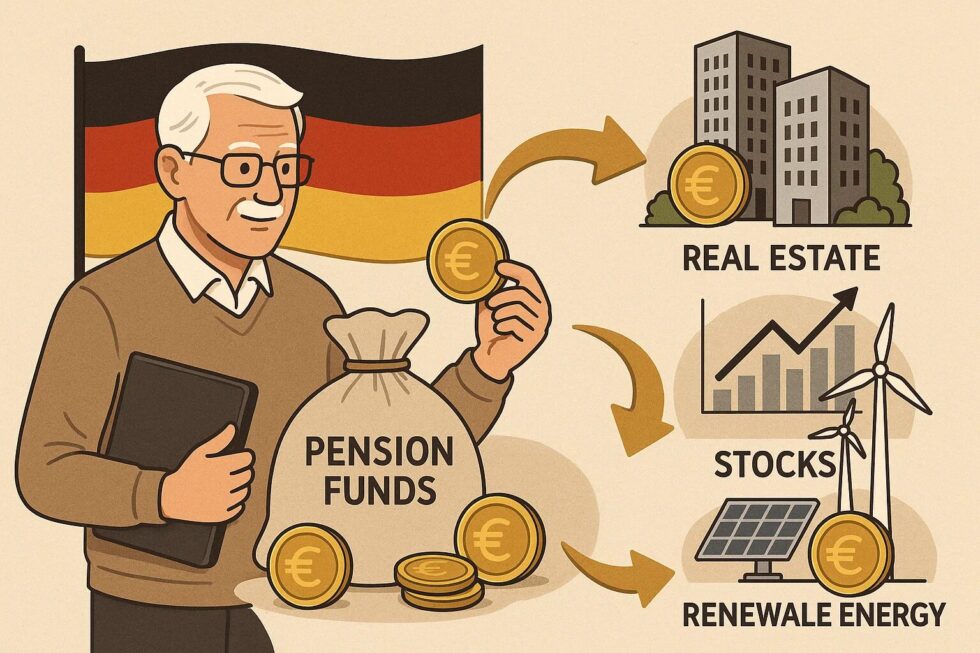German pension funds investments are under the spotlight in 2025 as billions of euros shift from traditional low-yield government bonds to a broader mix of sustainable infrastructure, private equity, real estate, and technology ventures. With Germany facing demographic change, low interest rates in the past decade, and rising inflationary pressures, the role of pension capital in shaping the national economy is growing stronger than ever. In recent years, funds have begun to prioritize renewable energy, green bonds, and healthcare projects, moving away from purely conservative debt markets. At the same time, stricter European Union regulations require transparency and ESG alignment, influencing where the money is allocated. Analysts note that more than €700 billion are managed by German pension institutions, with increasing exposure to international assets such as US tech companies and Asian logistics hubs. The dynamics raise important questions for retirees and policymakers alike about risk, stability, and long-term returns, reports G.business.
German pension funds and their economic role
German pension funds play a decisive role in the financial system, managing assets that account for nearly one fifth of the country’s GDP. Traditionally, most of these funds were invested in government bonds, safe corporate debt, and real estate. However, the past decade of ultra-low interest rates eroded returns, pushing managers to diversify into equities and alternative assets. In 2025, the funds are under pressure not only to ensure stability for millions of retirees but also to contribute to Germany’s broader economic transformation toward sustainability and digitalization.
With an aging population, the amount of pension capital is set to grow, but so do the liabilities. To address this imbalance, funds increasingly look abroad, investing in US infrastructure projects, renewable energy in Scandinavia, and Asian logistics. These shifts reflect a global hunt for yield but also raise concerns about exposure to geopolitical risks.
Key figures on German pension funds in 2025:
- Total managed assets: approx. €730 billion
- Share in government bonds: down to 32% (from 50% in 2015)
- Equities and private equity: 27%
- Real estate: 18%
- Renewable energy and green bonds: 12%
- Other international assets: 11%
The rise of ESG and sustainable investments
Sustainability has become a defining trend for German pension funds. New EU regulations under the Sustainable Finance Disclosure Regulation (SFDR) require funds to disclose how their portfolios meet environmental, social, and governance standards. This has driven a massive reallocation of assets from traditional industries like fossil fuels toward renewable energy, healthcare, and sustainable real estate.
Pension funds now actively invest in offshore wind parks in the North Sea, solar farms in Spain, and green urban development in German metropolitan areas. Analysts estimate that ESG-compliant assets already account for more than €200 billion of pension portfolios in 2025. This shift is also visible in the way funds vote at shareholder meetings, pressuring companies to reduce emissions and improve corporate governance.
Top ESG investment destinations for pension funds in 2025:
- Offshore wind projects in Germany and Denmark
- Solar parks in Southern Europe
- Green bonds issued by German municipalities
- Healthcare infrastructure (hospitals, clinics, elderly care)
- Smart city development projects
Real estate and infrastructure: stabilizing long-term returns
Real estate remains a cornerstone of pension investments, providing stable returns over decades. In Germany, funds are particularly focused on residential housing in major cities, commercial buildings in Frankfurt and Munich, and logistics centers along the Rhine-Ruhr corridor. However, high property prices and tighter regulation of rental markets have shifted part of the capital toward infrastructure.
Infrastructure investments are seen as a hedge against inflation, offering predictable cash flows. Pension funds now finance toll roads, airports, broadband expansion, and rail modernization. These projects align with Germany’s push for digital transformation and mobility upgrades, creating synergies between public policy and private capital.
Main infrastructure sectors attracting pension capital in 2025:
- Renewable energy grids
- Digital infrastructure (5G networks, fiber optics)
- Transport (rail, roads, airports)
- Social infrastructure (schools, hospitals, housing for the elderly)
International diversification: beyond German borders
While domestic investments remain central, German pension funds are increasingly looking abroad to diversify risk and boost returns. In 2025, approximately 35% of pension assets are invested outside Germany, compared to only 22% a decade ago. The United States remains the top destination, with allocations in technology, healthcare, and private equity funds. Asia, particularly China and India, is gaining ground thanks to booming logistics and digital markets.
However, international diversification comes with challenges. Currency risks, geopolitical tensions, and regulatory differences can erode returns. To mitigate these risks, funds often co-invest with other European pension institutions, spreading exposure across multiple markets.
International allocation of German pension funds in 2025:
| Region | Share of Assets | Key Sectors |
|---|---|---|
| United States | 18% | Tech, healthcare, private equity |
| Europe (ex-DE) | 10% | Renewable energy, logistics |
| Asia | 7% | Logistics, infrastructure, digital markets |
Private equity and technology as growth drivers
Another trend shaping German pension funds is the increasing allocation to private equity and technology. With stock markets volatile and bond yields low, private markets offer higher returns at the cost of higher risk. Pension funds now participate in venture capital rounds for startups in fintech, artificial intelligence, and biotech.
In 2025, around €70 billion of German pension money is tied to private equity funds, making them influential players in Europe’s innovation landscape. This trend reflects the broader strategy of aligning retirement capital with long-term growth industries. However, critics warn that higher risk exposure could undermine stability if market downturns occur.

Examples of pension-fund backed technology investments:
- German AI startups developing industrial automation
- Biotech companies in Munich and Berlin working on personalized medicine
- European fintech firms focusing on digital banking solutions
- US-based cloud infrastructure providers
Challenges: inflation, regulation, and demographic pressure
Despite diversification, German pension funds face multiple challenges. Inflation, while lower than in 2023, still erodes real returns. Regulators demand stricter capital requirements and ESG compliance, increasing costs for fund managers. Most importantly, demographic change places growing pressure on the system: by 2030, more than 25% of Germans will be over 65, while the workforce shrinks.
This imbalance creates a dilemma: funds must generate higher returns without taking excessive risks. Policymakers are debating reforms, such as raising the retirement age, adjusting contribution levels, or expanding funded pension systems to complement pay-as-you-go schemes. For pension funds, the challenge is to navigate between stability, profitability, and sustainability.
Main challenges for German pension funds in 2025:
- Persistent inflation around 3%
- Stricter EU regulations and compliance costs
- Demographic shift toward an aging population
- Geopolitical instability in investment regions
- Balancing ESG commitments with returns
Looking ahead, German pension funds are expected to increase allocations to green infrastructure, digital innovation, and international partnerships. The government’s €400 billion climate and digitalization plan offers opportunities for co-investment, while EU green bond markets provide new safe havens for capital. Analysts predict that by 2030, at least 50% of German pension portfolios will be ESG-compliant, making them one of the largest sustainable investors in Europe.
For pensioners, these strategies could secure more stable retirement income, but exposure to volatile markets remains a risk. Ultimately, the question is whether pension capital can balance security with the need to finance future growth.
Stay connected for news that works — timely, factual, and free from opinion — and insights that matter now: Do You Know How to Effectively Protect and Grow Capital During Economic Uncertainty
